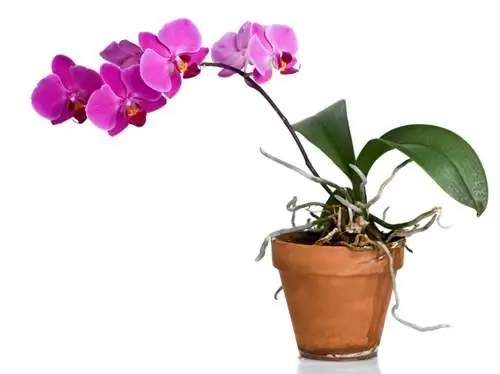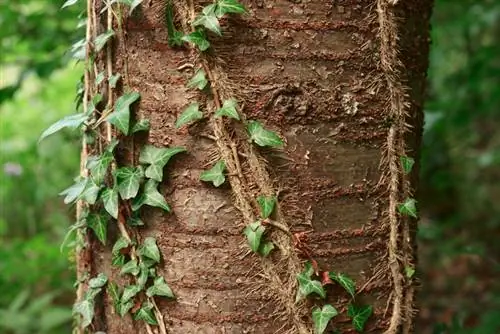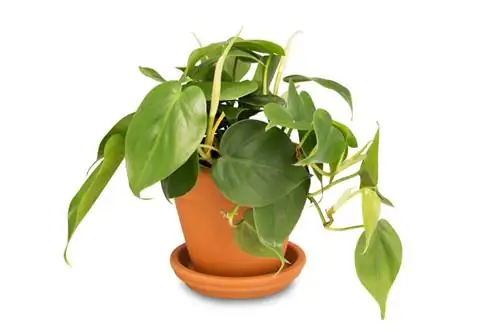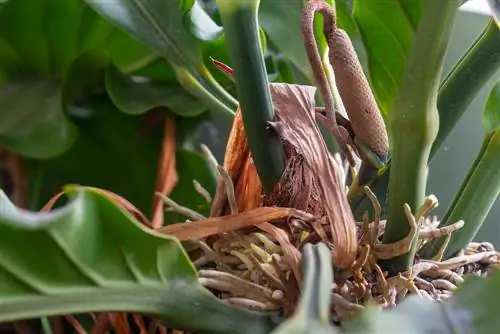- Author admin [email protected].
- Public 2023-12-16 16:46.
- Last modified 2025-06-01 06:02.
In addition to the unique flower, aerial roots are the most striking feature of orchids. Sometimes they grow out of the pot in a criss-cross pattern or, surprisingly, appear in the upper stem area. You can read about the function that aerial roots perform on orchids here. Benefit from our tips for proper care.
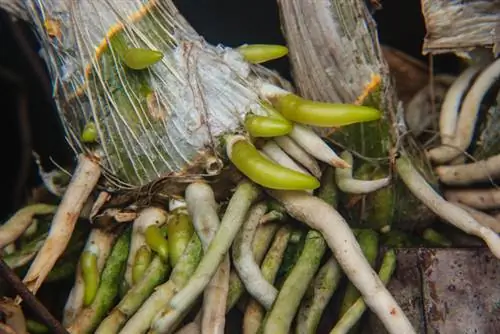
What are aerial roots in orchids and how do you care for them properly?
Aerial roots in orchids serve to fixate and supply the plant with moisture and nutrients. For care, they should be sprayed regularly and dipped in soft, room temperature water. He althy aerial roots should not be cut off, but should be repotted if necessary.
Lifeline and natural rope at the same time
In the physiology of orchids, aerial roots fulfill several tasks. They serve to fixate the countless epiphytic species high up in the crowns of huge jungle giants. So that the epiphytes do not lose their grip on the branches, they cling to them with part of their roots. The other part of their aerial roots captures the rain to transmit moisture and nutrients to the leaves and flowers.
Take care of aerial roots properly - that’s what matters
An orchid with juicy, silvery-green aerial roots is doing great. To keep it that way, please pay attention to the following care program:
- Spray aerial roots daily in summer, every 2-3 days in winter
- Depending on the temperature and season, dip the root ball in soft, room temperature water when it is dry
- Add orchid fertilizer (€15.00 on Amazon) to the submerged water every 4 weeks during the growth and flowering period
In order for aerial roots to optimally fulfill their function as a supply line, they depend on access to light. Therefore, always place an epiphytic orchid in a transparent culture pot. If you use a planter, it should be at least twice as large and have a platform inside for the transparent pot.
Please never cut off he althy aerial roots
If countless aerial roots protrude beyond the edge of the pot, please do not cut them off under any circumstances. With many aerial roots, the orchid signals the desire for a larger culture pot. Please repot the plant into a larger container with fresh orchid soil before or after the next flowering period. If the root network is in front of you without any substrate, dead aerial roots can be removed with a sharp, clean knife. A dipping bath makes the he althy root strands nice and supple so that they can be inserted into the new pot with a twisting motion.
Use aerial roots on the upper stem for propagation - This is how it works
One of the special qualities of the popular Phalaenopsis orchid is that it surprises us with aerial roots in the upper stem area. Where flowers should actually develop, the root strands protrude. These are offshoots that you can use for propagation. Once 2 to 3 small aerial roots and a few leaves have formed, cut off the child and place it in a small pot.
Tip
A few orchids survive without aerial roots. These are terrestrial orchids that prefer a place on safe ground. Vanilla planifolia is the only useful plant in the orchid kingdom, as are orchids and other native species. Terrestrial orchids prefer a loose, humus-rich substrate that is enriched with perlite, lava granules or small pieces of bark.


